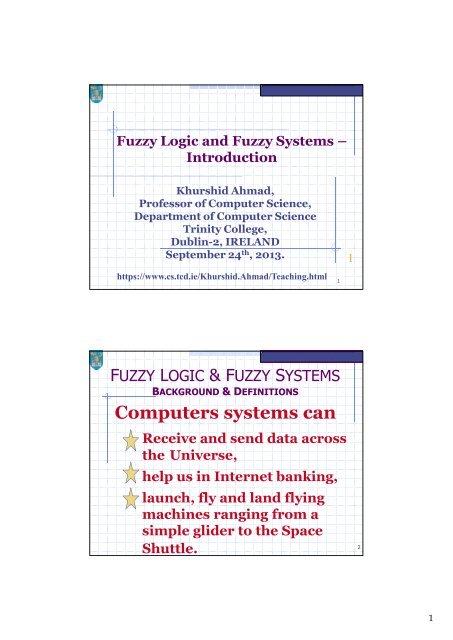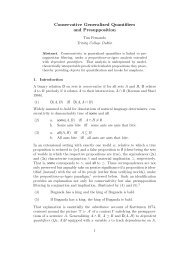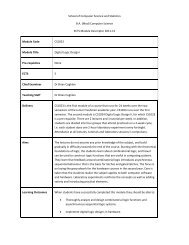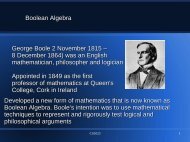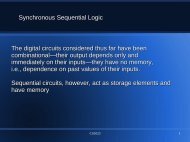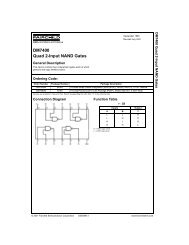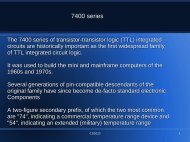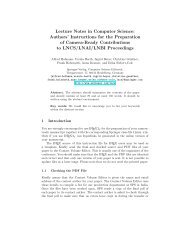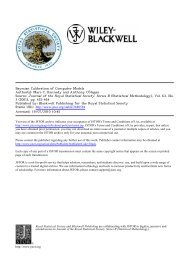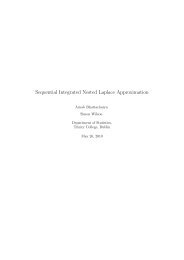Fuzzy Logic and Fuzzy Systems â Introduction - Trinity College Dublin
Fuzzy Logic and Fuzzy Systems â Introduction - Trinity College Dublin
Fuzzy Logic and Fuzzy Systems â Introduction - Trinity College Dublin
Create successful ePaper yourself
Turn your PDF publications into a flip-book with our unique Google optimized e-Paper software.
To help protect your privacy, PowerPoint prevented this external picture from being automatically downloaded. To download <strong>and</strong> display this picture, click Options in the Message Bar, <strong>and</strong> then click Enable external content.<br />
To help protect your privacy, PowerPoint prevented this external picture from being automatically downloaded. To download <strong>and</strong> display this picture, click Options in the Message Bar, <strong>and</strong> then click Enable external content.<br />
<strong>Fuzzy</strong> <strong>Logic</strong> <strong>and</strong> <strong>Fuzzy</strong> <strong>Systems</strong> –<br />
<strong>Introduction</strong><br />
Khurshid Ahmad,<br />
Professor of Computer Science,<br />
Department of Computer Science<br />
<strong>Trinity</strong> <strong>College</strong>,<br />
<strong>Dublin</strong>-2, IRELAND<br />
September 24 th , 2013.<br />
https://www.cs.tcd.ie/Khurshid.Ahmad/Teaching.html<br />
1<br />
1<br />
FUZZY LOGIC & FUZZY SYSTEMS<br />
BACKGROUND & DEFINITIONS<br />
Computers systems can<br />
Receive <strong>and</strong> send data across<br />
the Universe,<br />
help us in Internet banking,<br />
launch, fly <strong>and</strong> l<strong>and</strong> flying<br />
machines ranging from a<br />
simple glider to the Space<br />
Shuttle.<br />
2<br />
1
To help protect your privacy, PowerPoint prevented this external picture from being automatically downloaded. To download <strong>and</strong> display this picture, click Options in the Message Bar, <strong>and</strong> then click Enable external content.<br />
To help protect your privacy, PowerPoint prevented this external picture from being automatically downloaded. To download <strong>and</strong> display this picture, click Options in the Message Bar, <strong>and</strong> then click Enable external content.<br />
FUZZY LOGIC & FUZZY SYSTEMS<br />
BACKGROUND & DEFINITIONS<br />
Computer systems cannot<br />
satisfactorily manage information<br />
flowing across a hospital.<br />
The introduction of computer<br />
systems for public administration<br />
has invariably generated chaos.<br />
Computer systems have been found<br />
responsible for disasters like flood<br />
damage, fire control <strong>and</strong> so on.<br />
3<br />
FUZZY LOGIC & FUZZY SYSTEMS<br />
BACKGROUND & DEFINITIONS<br />
So why can’t the computers do<br />
what we want the computers to<br />
do?<br />
1. Problems in engineering software –<br />
specification, design, <strong>and</strong> testing;<br />
2. Algorithms, the basis of computer programs,<br />
cannot deal with partial information, with<br />
uncertainty;<br />
3. Much of human information processing relies<br />
significantly on approximate reasoning;<br />
4<br />
2
To help protect your privacy, PowerPoint prevented this external picture from being automatically downloaded. To download <strong>and</strong> display this picture, click Options in the Message Bar, <strong>and</strong> then click Enable external content.<br />
To help protect your privacy, PowerPoint prevented this external picture from being automatically downloaded. To download <strong>and</strong> display this picture, click Options in the Message Bar, <strong>and</strong> then click Enable external content.<br />
FUZZY LOGIC & FUZZY SYSTEMS<br />
BACKGROUND & DEFINITIONS<br />
Year<br />
Definition & Elaboration of the adjective fuzzy<br />
1616 1. Not firm or sound in substance; spongy.<br />
1713 2. Frayed into loose fibres; covered with<br />
fuzz; fluffy, downy.<br />
1778 3a. Blurred, indistinct.<br />
1937 3b. Of thought, etc.: imprecisely defined;<br />
confused, vague. Also of persons: inexact in<br />
thought or expression.<br />
From the Oxford English Dictionary. http://www.oed.com.elib.tcd.ie/view/Entry/75880<br />
5<br />
FUZZY LOGIC & FUZZY SYSTEMS<br />
BACKGROUND & DEFINITIONS<br />
Year Definition & Elaboration of the adjective fuzzy<br />
1964 3c.i Computing <strong>and</strong> <strong>Logic</strong>. [<strong>Fuzzy</strong> Set] (Of a<br />
set) defined so as to allow for imprecise<br />
membership criteria <strong>and</strong> for gradations of<br />
membership; pertaining or belonging to such<br />
a set;<br />
3c.ii fuzzy logic, the logic of fuzzy sets <strong>and</strong><br />
fuzzy concepts; fuzzy matching, (the facility<br />
for) matching items which are similar but not<br />
identical.<br />
From the Oxford English Dictionary. http://www.oed.com.elib.tcd.ie/view/Entry/75880<br />
6<br />
3
To help protect your privacy, PowerPoint prevented this external picture from being automatically downloaded. To download <strong>and</strong> display this picture, click Options in the Message Bar, <strong>and</strong> then click Enable external content.<br />
To help protect your privacy, PowerPoint prevented this external picture from being automatically downloaded. To download <strong>and</strong> display this picture, click Options in the Message Bar, <strong>and</strong> then click Enable external content.<br />
FUZZY LOGIC & FUZZY SYSTEMS<br />
BACKGROUND & DEFINITIONS<br />
Soft computing is used as an<br />
umbrella term for subdisciplines<br />
of computing,<br />
including fuzzy logic <strong>and</strong> fuzzy<br />
control, neural networks based<br />
computing <strong>and</strong> machine<br />
learning, <strong>and</strong> genetic<br />
algorithms, together with chaos<br />
theory in mathematics.<br />
7<br />
FUZZY LOGIC & FUZZY SYSTEMS<br />
BACKGROUND & DEFINITIONS<br />
Soft computing is for the near<br />
future – next 5-10 years, <strong>and</strong><br />
knowledge of the inclusive<br />
branches will help to work in<br />
almost every enterprise where<br />
computers are expected in<br />
helping with design, control<br />
<strong>and</strong> execution of complex<br />
processes.<br />
8<br />
4
To help protect your privacy, PowerPoint prevented this external picture from being automatically downloaded. To download <strong>and</strong> display this picture, click Options in the Message Bar, <strong>and</strong> then click Enable external content.<br />
To help protect your privacy, PowerPoint prevented this external picture from being automatically downloaded. To download <strong>and</strong> display this picture, click Options in the Message Bar, <strong>and</strong> then click Enable external content.<br />
FUZZY LOGIC & FUZZY SYSTEMS<br />
BACKGROUND & DEFINITIONS<br />
This course will focus on fuzzy logic<br />
<strong>and</strong> fuzzy control systems; there is<br />
a brief introduction to neural<br />
networks.<br />
A knowledge of soft computing<br />
techniques will help you to work<br />
with folks involved with patient<br />
care, public administration for<br />
instance.<br />
9<br />
FUZZY LOGIC & FUZZY SYSTEMS<br />
BACKGROUND & DEFINITIONS<br />
You have probably only encountered<br />
st<strong>and</strong>ard systems of logic – Boolean<br />
<strong>Logic</strong>, First-order logic. However,<br />
there are non-st<strong>and</strong>ard logics –<br />
future-conditional logic, logics used<br />
by von Neumann in the development<br />
of quantum mechanics (Boolean logic<br />
with quantum uncertainty). <strong>Fuzzy</strong><br />
logic may be regarded as an<br />
alternative or deviant logic.<br />
10<br />
5
To help protect your privacy, PowerPoint prevented this external picture from being automatically downloaded. To download <strong>and</strong> display this picture, click Options in the Message Bar, <strong>and</strong> then click Enable external content.<br />
To help protect your privacy, PowerPoint prevented this external picture from being automatically downloaded. To download <strong>and</strong> display this picture, click Options in the Message Bar, <strong>and</strong> then click Enable external content.<br />
FUZZY LOGIC & FUZZY SYSTEMS<br />
BACKGROUND & DEFINITIONS<br />
You have probably only encountered<br />
classical control theory – the control<br />
<strong>and</strong> stabilization of a dynamical<br />
system by corrective action from an<br />
external control. However, such<br />
systems rely on the existence of<br />
mathematical <strong>and</strong> statistical<br />
formalisms (differential equations,<br />
Markov models), that are usually<br />
available for idealised situations.<br />
11<br />
FUZZY LOGIC & FUZZY SYSTEMS<br />
BACKGROUND & DEFINITIONS<br />
Your perception is imprecise as well:<br />
Consider the two images:<br />
Is there a systematic difference between what you<br />
consider a tall/short woman <strong>and</strong> a tall short man?<br />
12<br />
6
To help protect your privacy, PowerPoint prevented this external picture from being automatically downloaded. To download <strong>and</strong> display this picture, click Options in the Message Bar, <strong>and</strong> then click Enable external content.<br />
To help protect your privacy, PowerPoint prevented this external picture from being automatically downloaded. To download <strong>and</strong> display this picture, click Options in the Message Bar, <strong>and</strong> then click Enable external content.<br />
FUZZY LOGIC & FUZZY SYSTEMS<br />
UNCERTAINITY AND ITS TREATMENT<br />
Course Content<br />
1. Terminology: Uncertainty,<br />
Approximations <strong>and</strong> Vagueness<br />
2. <strong>Fuzzy</strong> Sets<br />
3. <strong>Fuzzy</strong> <strong>Logic</strong> <strong>and</strong> <strong>Fuzzy</strong> <strong>Systems</strong><br />
4. <strong>Fuzzy</strong> Control<br />
5. Neuro-fuzzy systems<br />
13<br />
FUZZY LOGIC & FUZZY SYSTEMS<br />
BACKGROUND & DEFINITIONS<br />
<strong>Fuzzy</strong> logic is being developed as a<br />
discipline to meet two objectives:<br />
1. As a professional subject dedicated to the<br />
building of systems of high utility – for<br />
example fuzzy control<br />
2. As a theoretical subject – fuzzy logic is<br />
“symbolic logic with a comparative notion<br />
of truth developed fully in the spirit of<br />
classical logic [..] It is a branch of manyvalued<br />
logic based on the paradigm of<br />
inference under vagueness.<br />
14<br />
7
To help protect your privacy, PowerPoint prevented this external picture from being automatically downloaded. To download <strong>and</strong> display this picture, click Options in the Message Bar, <strong>and</strong> then click Enable external content.<br />
To help protect your privacy, PowerPoint prevented this external picture from being automatically downloaded. To download <strong>and</strong> display this picture, click Options in the Message Bar, <strong>and</strong> then click Enable external content.<br />
FUZZY LOGIC & FUZZY SYSTEMS<br />
BACKGROUND & DEFINITIONS<br />
The key point is this<br />
We can be sure of the truth of the statement:<br />
Jones/Jill is tall<br />
But unsure of the truth of the statement:<br />
Jones/Jill is 1.8297 metres tall<br />
Hhack, Susan. (1974). Deviant <strong>Logic</strong>: Some philosophical Issues. Cambridge: Cambridge University Press.<br />
15<br />
FUZZY LOGIC & FUZZY SYSTEMS<br />
BACKGROUND & DEFINITIONS<br />
The key point is this<br />
The laws of physics can acquire this minuteness<br />
of detail only by sacrificing some of the fixed<br />
<strong>and</strong> absolute certainty of common-sense laws.<br />
There is a sort of balance between precision <strong>and</strong><br />
certainty: one cannot be increased except to the<br />
detriment of the other. (Haack citing the<br />
philosopher Pierre Duhem, 1974:123).<br />
Hhack, Susan. (1974). Deviant <strong>Logic</strong>: Some philosophical Issues. Cambridge: Cambridge University Press.<br />
16<br />
8
To help protect your privacy, PowerPoint prevented this external picture from being automatically downloaded. To download <strong>and</strong> display this picture, click Options in the Message Bar, <strong>and</strong> then click Enable external content.<br />
To help protect your privacy, PowerPoint prevented this external picture from being automatically downloaded. To download <strong>and</strong> display this picture, click Options in the Message Bar, <strong>and</strong> then click Enable external content.<br />
FUZZY LOGIC & FUZZY SYSTEMS<br />
BACKGROUND & DEFINITIONS<br />
Engineering & Technology<br />
When confronted with a control problem for a<br />
complicated physical process, a control engineer<br />
generally follows a relatively systematic design<br />
procedure. A simple example of a control problem<br />
is an automobile “cruise control” that provides the<br />
automobile with the capability of regulating its<br />
own speed at a driver-specified set-point (e.g., 55<br />
mph).<br />
Kevin M. Passino <strong>and</strong> Stephen Yurkovich. (1998). <strong>Fuzzy</strong> control . California:<br />
Addison Wesley Longman, Inc<br />
17<br />
FUZZY LOGIC & FUZZY SYSTEMS<br />
BACKGROUND & DEFINITIONS<br />
Engineering & Technology<br />
One solution to the automotive cruise control<br />
problem involves adding an electronic controller<br />
that can sense the speed of the vehicle via the<br />
speedometer <strong>and</strong> actuate the throttle position so<br />
as to regulate the vehicle speed as close as possible<br />
to the driver-specified value (the design<br />
objective). Such speed regulation must be<br />
accurate even if there are road grade changes,<br />
head winds, or variations in the number of<br />
passengers or amount of cargo in the automobile.<br />
Kevin M. Passino <strong>and</strong> Stephen Yurkovich. (1998). <strong>Fuzzy</strong> control . California: Addison Wesley Longman, Inc<br />
18<br />
9
To help protect your privacy, PowerPoint prevented this external picture from being automatically downloaded. To download <strong>and</strong> display this picture, click Options in the Message Bar, <strong>and</strong> then click Enable external content.<br />
To help protect your privacy, PowerPoint prevented this external picture from being automatically downloaded. To download <strong>and</strong> display this picture, click Options in the Message Bar, <strong>and</strong> then click Enable external content.<br />
FUZZY LOGIC & FUZZY SYSTEMS<br />
BACKGROUND & DEFINITIONS<br />
Medicine<br />
The diagnosis of disease involves several levels of<br />
uncertainty <strong>and</strong> imprecision, <strong>and</strong> it is inherent to<br />
medicine. A single disease may manifest itself quite<br />
differently, depending on the patient, <strong>and</strong> with<br />
different intensities. A single symptom may<br />
correspond to different diseases. On the other<br />
h<strong>and</strong>, several diseases present in a patient may<br />
interact <strong>and</strong> interfere with the usual description of<br />
any of the diseases.<br />
Angela Torres <strong>and</strong> Juan J. Nieto (2006). <strong>Fuzzy</strong> <strong>Logic</strong> in Medicine <strong>and</strong> Bioinformatics. Journal of<br />
Biomedicine <strong>and</strong> Biotechnology. Volume 2006, Article ID 91908, Pages 1–7. (DOI<br />
10.1155/JBB/2006/91908)<br />
19<br />
FUZZY LOGIC & FUZZY SYSTEMS<br />
BACKGROUND & DEFINITIONS<br />
Medicine<br />
The best <strong>and</strong> most precise description of<br />
disease entities uses linguistic terms that are<br />
also imprecise <strong>and</strong> vague. Moreover, the<br />
classical concepts of health <strong>and</strong> disease are<br />
mutually exclusive <strong>and</strong> opposite. However,<br />
some recent approaches consider both<br />
concepts as complementary processes in the<br />
same continuum.<br />
Angela Torres <strong>and</strong> Juan J. Nieto (2006). <strong>Fuzzy</strong> <strong>Logic</strong> in Medicine <strong>and</strong> Bioinformatics. Journal of<br />
Biomedicine <strong>and</strong> Biotechnology. Volume 2006, Article ID 91908, Pages 1–7. (DOI<br />
10.1155/JBB/2006/91908)<br />
20<br />
10
To help protect your privacy, PowerPoint prevented this external picture from being automatically downloaded. To download <strong>and</strong> display this picture, click Options in the Message Bar, <strong>and</strong> then click Enable external content.<br />
To help protect your privacy, PowerPoint prevented this external picture from being automatically downloaded. To download <strong>and</strong> display this picture, click Options in the Message Bar, <strong>and</strong> then click Enable external content.<br />
FUZZY LOGIC & FUZZY SYSTEMS<br />
BACKGROUND & DEFINITIONS<br />
Objective<br />
Subjective<br />
Medicine: Patient History<br />
Precise<br />
Vital Signs, Lab<br />
Results, Diagnostic<br />
Tests<br />
Mental disorder<br />
classification;<br />
Contraindications to<br />
drugs/therapy<br />
Imprecise<br />
Patient behaving<br />
improperly during signs<br />
taking, diagnostic tests<br />
Medical history<br />
supplied by<br />
patient/family<br />
Angela Torres <strong>and</strong> Juan J. Nieto (2006). <strong>Fuzzy</strong> <strong>Logic</strong> in Medicine <strong>and</strong> Bioinformatics. Journal of<br />
Biomedicine <strong>and</strong> Biotechnology. Volume 2006, Article ID 91908, Pages 1–7. (DOI<br />
10.1155/JBB/2006/91908)<br />
21<br />
FUZZY LOGIC & FUZZY SYSTEMS<br />
BACKGROUND & DEFINITIONS<br />
Economics, Finance & Politics<br />
Many decisions are based on beliefs concerning<br />
the likelihood of uncertain events such as the<br />
outcome of an election, the guilt of a defendant, or<br />
the future value of the dollar. These beliefs are<br />
usually expressed in statements such as "I think<br />
that . . . ," "chances are . . . ," "it is unlikely that .<br />
. . ," <strong>and</strong> so forth.<br />
Amos Tversky; Daniel Kahneman. Judgment under Uncertainty: Heuristics <strong>and</strong><br />
Biases. Science, New Series, Vol. 185, No. 4157. (Sep. 27, 1974), pp. 1124-1131.<br />
22<br />
11
To help protect your privacy, PowerPoint prevented this external picture from being automatically downloaded. To download <strong>and</strong> display this picture, click Options in the Message Bar, <strong>and</strong> then click Enable external content.<br />
To help protect your privacy, PowerPoint prevented this external picture from being automatically downloaded. To download <strong>and</strong> display this picture, click Options in the Message Bar, <strong>and</strong> then click Enable external content.<br />
FUZZY LOGIC & FUZZY SYSTEMS<br />
BACKGROUND & DEFINITIONS<br />
Economics, Finance & Politics<br />
Occasionally, beliefs concerning uncertain<br />
events are expressed in numerical form as<br />
odds or subjective probabilities. What<br />
determines such beliefs? How do people<br />
assess the probability of an uncertain event<br />
or the value of an uncertain quantity?<br />
Amos Tversky; Daniel Kahneman. Judgment under Uncertainty: Heuristics <strong>and</strong><br />
Biases. Science, New Series, Vol. 185, No. 4157. (Sep. 27, 1974), pp. 1124-1131.<br />
23<br />
FUZZY LOGIC & FUZZY SYSTEMS<br />
BACKGROUND & DEFINITIONS<br />
Economics, Finance & Politics<br />
Occasionally, beliefs concerning uncertain<br />
events are expressed in numerical form as<br />
odds or subjective probabilities. What<br />
determines such beliefs? How do people<br />
assess the probability of an uncertain event<br />
or the value of an uncertain quantity?<br />
Amos Tversky; Daniel Kahneman. Judgment under Uncertainty: Heuristics <strong>and</strong><br />
Biases. Science, New Series, Vol. 185, No. 4157. (Sep. 27, 1974), pp. 1124-1131.<br />
24<br />
12
To help protect your privacy, PowerPoint prevented this external picture from being automatically downloaded. To download <strong>and</strong> display this picture, click Options in the Message Bar, <strong>and</strong> then click Enable external content.<br />
To help protect your privacy, PowerPoint prevented this external picture from being automatically downloaded. To download <strong>and</strong> display this picture, click Options in the Message Bar, <strong>and</strong> then click Enable external content.<br />
FUZZY LOGIC & FUZZY SYSTEMS<br />
UNCERTAINITY AND ITS TREATMENT<br />
How rice is cooked: Cooking white rice is a<br />
four-phase process.<br />
• First, soak rice in water for a while;<br />
• Second, bring the water to boil <strong>and</strong> keep the<br />
temperature to boiling point of water;<br />
• Third, temperature increases now, tone down the<br />
heat;<br />
• Fourth, few minutes afterwards, the rice s ready.<br />
http://www.fuzzylogicricecooker.org/<br />
25<br />
FUZZY LOGIC & FUZZY SYSTEMS<br />
UNCERTAINITY AND ITS TREATMENT<br />
How rice is cooked: Cooking white rice is a four-phase<br />
process. First, water is added to a pot that has ample<br />
capacity so the white rice sits in water. Then using a source<br />
of heat like a gas stove or electric plate, the mixture is<br />
heated until it is boiling <strong>and</strong> the white rice is absorbing<br />
water. The temperature remains at 212 degrees<br />
Fahrenheit, which is the boiling point of water. Part of the<br />
water turns into steam <strong>and</strong> escapes into the air. When all<br />
of the water is gone from the rice on the stove, the<br />
temperature increases. Now it is resting <strong>and</strong> there is a<br />
need to tone down the heat <strong>and</strong> to cut it off later. A few<br />
minutes afterwards, the rice is ready for serving. As we<br />
can see, there is a lot of important timing, especially at the<br />
latter phases.<br />
26<br />
13
To help protect your privacy, PowerPoint prevented this external picture from being automatically downloaded. To download <strong>and</strong> display this picture, click Options in the Message Bar, <strong>and</strong> then click Enable external content.<br />
To help protect your privacy, PowerPoint prevented this external picture from being automatically downloaded. To download <strong>and</strong> display this picture, click Options in the Message Bar, <strong>and</strong> then click Enable external content.<br />
FUZZY LOGIC & FUZZY SYSTEMS<br />
UNCERTAINITY AND ITS TREATMENT<br />
Applying brakes to stop a passenger train:<br />
Oshirra, Hircryasu., Seiji<br />
Yasunobu <strong>and</strong> Shin-ichi<br />
Sekino. (1988). Automatic<br />
train operation system on<br />
predictive fuzzy control. In<br />
Proc. International<br />
Workshop on Artificial<br />
Intelligence for Industrial<br />
Applications. pp 485-489.<br />
http://ieeexplore.ieee.org.elib.t<br />
cd.ie/xpl/mostRecentIssue.jsp?<br />
punumber=714<br />
27<br />
FUZZY LOGIC & FUZZY SYSTEMS<br />
UNCERTAINITY AND ITS TREATMENT<br />
Oshirra, et<br />
al(1988)..<br />
(1) CONSTANT<br />
SPEED<br />
CONTROL<br />
(CSC)<br />
(2) TRAIN<br />
AUTOMATIC<br />
STOPPING<br />
CONTROL<br />
(TASC)<br />
28<br />
14
To help protect your privacy, PowerPoint prevented this external picture from being automatically downloaded. To download <strong>and</strong> display this picture, click Options in the Message Bar, <strong>and</strong> then click Enable external content.<br />
To help protect your privacy, PowerPoint prevented this external picture from being automatically downloaded. To download <strong>and</strong> display this picture, click Options in the Message Bar, <strong>and</strong> then click Enable external content.<br />
FUZZY LOGIC & FUZZY SYSTEMS<br />
UNCERTAINITY AND ITS TREATMENT<br />
Oshirra, et<br />
al (1988)..<br />
<strong>Fuzzy</strong><br />
Control<br />
gives a<br />
smoother<br />
ride!<br />
29<br />
FUZZY LOGIC & FUZZY SYSTEMS<br />
UNCERTAINITY AND ITS TREATMENT<br />
Reacting to unexpected <strong>and</strong> expected situations: A robot showing<br />
‘human emotions’. Somebody intruding in your space !<br />
Relating PERCEPTION to EMOTION<br />
Hossein Mobahi <strong>and</strong> Shahin Ansari. (2003)<strong>Fuzzy</strong> Perception, Emotion <strong>and</strong> Expression for Interactive Robots. IEEE<br />
International Conference on <strong>Systems</strong>, Man <strong>and</strong> Cybernetics, 5-8 Oct. 2003., Vol 4. pp 3918-3923<br />
http://ieeexplore.ieee.org/xpl/freeabs_all.jsp?arnumber=1244500<br />
30<br />
15
To help protect your privacy, PowerPoint prevented this external picture from being automatically downloaded. To download <strong>and</strong> display this picture, click Options in the Message Bar, <strong>and</strong> then click Enable external content.<br />
To help protect your privacy, PowerPoint prevented this external picture from being automatically downloaded. To download <strong>and</strong> display this picture, click Options in the Message Bar, <strong>and</strong> then click Enable external content.<br />
FUZZY LOGIC & FUZZY SYSTEMS<br />
UNCERTAINITY AND ITS TREATMENT<br />
Reacting to unexpected <strong>and</strong> expected situations: A robot showing<br />
‘human emotions’. Somebody intruding in your space !<br />
Heuristics for fear, anger <strong>and</strong><br />
surprise when somebody<br />
approaches you slowly of fast,<br />
(or you encounter a stationary<br />
object). The reaction to an<br />
intruder also depends on<br />
whether you are close to the<br />
intruder or some distance away.<br />
Hossein Mobahi <strong>and</strong> Shahin Ansari. (2003)<strong>Fuzzy</strong> Perception, Emotion <strong>and</strong> Expression for Interactive Robots. IEEE International<br />
Conference on <strong>Systems</strong>, Man <strong>and</strong> Cybernetics, 5-8 Oct. 2003., Vol 4. pp 3918-3923<br />
http://ieeexplore.ieee.org/xpl/freeabs_all.jsp?arnumber=1244500<br />
31<br />
FUZZY LOGIC & FUZZY SYSTEMS<br />
UNCERTAINITY AND ITS TREATMENT<br />
Reacting to unexpected <strong>and</strong> expected situations: A robot showing<br />
‘human emotions’. Somebody intruding in your space ! A single<br />
variable mapping – SPEED or DISTANCE + {Emotion}<br />
PERCEPTION<br />
EMOTION<br />
DISTANCE<br />
IF the intruder is Far away THEN we have No Fear<br />
IF the intruder is Very Near THEN we are Not Surprised<br />
SPEED<br />
IF the intruder is Stationary THEN we have No Fear<br />
IF the intruder is moving Fast THEN we are Not Angry<br />
32<br />
16
To help protect your privacy, PowerPoint prevented this external picture from being automatically downloaded. To download <strong>and</strong> display this picture, click Options in the Message Bar, <strong>and</strong> then click Enable external content.<br />
To help protect your privacy, PowerPoint prevented this external picture from being automatically downloaded. To download <strong>and</strong> display this picture, click Options in the Message Bar, <strong>and</strong> then click Enable external content.<br />
A<br />
C<br />
o<br />
n<br />
ti<br />
n<br />
g<br />
e<br />
n<br />
c<br />
y<br />
t<br />
a<br />
b<br />
le<br />
FUZZY LOGIC & FUZZY SYSTEMS<br />
UNCERTAINITY AND ITS TREATMENT<br />
Reacting to unexpected <strong>and</strong> expected situations: A robot showing<br />
‘human emotions’. Somebody intruding in your space ! A two variable<br />
mapping – SPEED <strong>and</strong> DISTANCE + {Emotion}<br />
Distance<br />
Very Near<br />
Far<br />
Stationary<br />
Very Angry, Not<br />
surprised, No<br />
Fear<br />
Very Angry, Not<br />
surprised, No<br />
Fear<br />
Speed<br />
Fast<br />
Not Angry,<br />
Not surprised,<br />
Very Fearful<br />
Not Angry, Very<br />
Surprised, No<br />
Fear<br />
33<br />
FUZZY LOGIC & FUZZY SYSTEMS<br />
UNCERTAINITY AND ITS TREATMENT<br />
Reacting to unexpected <strong>and</strong> expected situations: A robot showing<br />
‘human emotions’. Somebody intruding in your space ! A two variable<br />
mapping – SPEED <strong>and</strong> DISTANCE + {Emotion}<br />
Distance<br />
Speed<br />
Stationary Slow Fast<br />
Very Near VA, NS, NF A, NS, F NA, NS, VF<br />
Near A, NS, NF NA, NS, NF NA, S, F<br />
Far VA, NS, NF A, S, NF NA, VS, NF<br />
34<br />
17
To help protect your privacy, PowerPoint prevented this external picture from being automatically downloaded. To download <strong>and</strong> display this picture, click Options in the Message Bar, <strong>and</strong> then click Enable external content.<br />
To help protect your privacy, PowerPoint prevented this external picture from being automatically downloaded. To download <strong>and</strong> display this picture, click Options in the Message Bar, <strong>and</strong> then click Enable external content.<br />
FUZZY LOGIC & FUZZY SYSTEMS<br />
UNCERTAINITY AND ITS TREATMENT<br />
Reacting to unexpected <strong>and</strong> expected situations: A robot showing<br />
‘human emotions’. Somebody intruding in your space ! A two variable<br />
mapping – SPEED <strong>and</strong> DISTANCE + {Emotion}<br />
Emotional<br />
Linguistic<br />
Variable<br />
ANGER:<br />
SURPRISE:<br />
FEAR:<br />
Term Set<br />
{VA Very Angry; A Angry; NA Not<br />
Angry}<br />
{VS Very Surprised; S Surprised;<br />
NS Not Surprised}<br />
{VF Very Fearful; F Fearful; NF <br />
No Fear}<br />
35<br />
FUZZY LOGIC & FUZZY SYSTEMS<br />
UNCERTAINITY AND ITS TREATMENT<br />
Reacting to unexpected <strong>and</strong> expected situations: A robot showing<br />
‘human emotions’. Somebody intruding in your space ! A two variable<br />
mapping – SPEED <strong>and</strong> DISTANCE + {Emotion}<br />
Perception<br />
Linguistic<br />
Variable<br />
SPEED:<br />
DISTANCE:<br />
Term Set<br />
{F Fast; SL Slow; ST<br />
Stationary<br />
{VN Very Near; N <br />
Near; F Far Away}<br />
36<br />
18
To help protect your privacy, PowerPoint prevented this external picture from being automatically downloaded. To download <strong>and</strong> display this picture, click Options in the Message Bar, <strong>and</strong> then click Enable external content.<br />
To help protect your privacy, PowerPoint prevented this external picture from being automatically downloaded. To download <strong>and</strong> display this picture, click Options in the Message Bar, <strong>and</strong> then click Enable external content.<br />
FUZZY LOGIC & FUZZY SYSTEMS<br />
UNCERTAINITY AND ITS TREATMENT<br />
What are fuzzy sets <strong>and</strong> systems<br />
The theory of fuzzy sets<br />
now encompasses a corpus<br />
of basic notions including<br />
[..] aggregation operations,<br />
a generalized theory of<br />
relations, specific measures<br />
of information content, a<br />
calculus of fuzzy numbers.<br />
37<br />
FUZZY LOGIC & FUZZY SYSTEMS<br />
UNCERTAINITY AND ITS TREATMENT<br />
What are fuzzy sets <strong>and</strong> systems<br />
<strong>Fuzzy</strong> sets have led to<br />
(1)a non-additive<br />
uncertainty theory<br />
[..possibility theory,]<br />
(2)[a] tool for both<br />
linguistic <strong>and</strong><br />
numerical modeling:<br />
fuzzy rule-based<br />
systems.<br />
38<br />
19
To help protect your privacy, PowerPoint prevented this external picture from being automatically downloaded. To download <strong>and</strong> display this picture, click Options in the Message Bar, <strong>and</strong> then click Enable external content.<br />
To help protect your privacy, PowerPoint prevented this external picture from being automatically downloaded. To download <strong>and</strong> display this picture, click Options in the Message Bar, <strong>and</strong> then click Enable external content.<br />
FUZZY LOGIC & FUZZY SYSTEMS<br />
UNCERTAINITY AND ITS TREATMENT<br />
Perception <strong>and</strong> Gender<br />
When we look at men <strong>and</strong> women, our<br />
perception of the heights is approximate <strong>and</strong><br />
motivated by pre-conceptions of what it takes<br />
to be a tall man or short woman.<br />
It appears that the very quantitative concept of<br />
height has an in-built uncertainty.<br />
P. J. MACVICAR-WHELAN (1978). <strong>Fuzzy</strong> Sets, the Concept of Height, <strong>and</strong> the Hedge<br />
VERY. IEEE TRANSACTIONS ON SYSTEMS, MAN, AND CYBERNETICS, VOL.<br />
SMC-8, NO. 6, JUNE 1978, pp 507-511<br />
39<br />
FUZZY LOGIC & FUZZY SYSTEMS<br />
UNCERTAINITY AND ITS TREATMENT<br />
Perception <strong>and</strong> Gender<br />
MacVicar-Whelan (1978) conducted ‘an experimental <strong>and</strong><br />
theoretical study of the categorization of human height is<br />
reported. Subjects of both sexes whose ages ranged from 6 to<br />
72 were asked to class the height of both men <strong>and</strong> women<br />
using the labels VERY VERY SHORT, VERY SHORT,<br />
SHORT, TALL, VERY TALL, <strong>and</strong> VERY VERY TALL. The<br />
experimental results confirm Zadeh's contention about the<br />
existence of fuzzy classification (the lack of sharp borders for<br />
the classes)<br />
P. J. MACVICAR-WHELAN (1978). <strong>Fuzzy</strong> Sets, the Concept of Height, <strong>and</strong> the Hedge<br />
VERY. IEEE TRANSACTIONS ON SYSTEMS, MAN, AND CYBERNETICS, VOL.<br />
SMC-8, NO. 6, JUNE 1978, pp 507-511<br />
40<br />
20
To help protect your privacy, PowerPoint prevented this external picture from being automatically downloaded. To download <strong>and</strong> display this picture, click Options in the Message Bar, <strong>and</strong> then click Enable external content.<br />
To help protect your privacy, PowerPoint prevented this external picture from being automatically downloaded. To download <strong>and</strong> display this picture, click Options in the Message Bar, <strong>and</strong> then click Enable external content.<br />
FUZZY LOGIC & FUZZY SYSTEMS<br />
UNCERTAINITY AND ITS TREATMENT<br />
Perception <strong>and</strong> Gender: Term sets of heights were assigned<br />
different values by human observers in a controlled psychological<br />
experiment<br />
Gender<br />
Height in Centimetres<br />
Very Very<br />
Short<br />
Very<br />
Short SHORT TALL<br />
Very<br />
Tall<br />
Very Very Tall<br />
Men 138.7 143.1 156.8 179.4 189.5 197.7<br />
Women 134.8 143.0 149.2 172.9 181.4 190.9<br />
41<br />
FUZZY LOGIC & FUZZY SYSTEMS<br />
BACKGROUND & DEFINITIONS<br />
Perception of Men’s Height – figures in inches here<br />
OBSERVER<br />
Short<br />
Tall<br />
Very<br />
Very Very Just Very Very Very Just<br />
F1 59.2 (±1) 61.8 (±1) 67.0 (±2) 80.5 (2.5) 77(±2) 71.5(±1)<br />
F8 44.4 (±1) 46.5(±3) 57.2 (±4.2) 75.2(±6) 68.2 (±10.8)<br />
M11<br />
53.0 (±<br />
10) 54.0 (±11.7) 55. (±11.5) 80.4 (±7.5) 78.0 (±4)<br />
66.3 (±<br />
12)<br />
75.2<br />
(±6.5)<br />
AVERAGE<br />
(8 obs; 2-3<br />
methods) 54.6 ( 4.5) 56.34 (±5.58)<br />
61.73<br />
(5.75)<br />
77.85<br />
(±6.27)<br />
74.60<br />
42<br />
±5.32) 70.64 (±5)<br />
21
To help protect your privacy, PowerPoint prevented this external picture from being automatically downloaded. To download <strong>and</strong> display this picture, click Options in the Message Bar, <strong>and</strong> then click Enable external content.<br />
To help protect your privacy, PowerPoint prevented this external picture from being automatically downloaded. To download <strong>and</strong> display this picture, click Options in the Message Bar, <strong>and</strong> then click Enable external content.<br />
FUZZY LOGIC & FUZZY SYSTEMS<br />
BACKGROUND & DEFINITIONS<br />
Perception of Women’s Height – figures in inches here<br />
Short<br />
Tall<br />
OBSERVER Very Very Very Just Very Very Very Just<br />
F1 55 (±2) 57.5 (±2) 60 (±2) 78 (±2) 74.5 (±2) 70.4 (±1)<br />
F8 52.4 (±5) 57.2 (±4) 52.4 (±9) 76.5 (±9.5) 73.2 (±10) 69.0 (±6)<br />
M11 49.5 (± 11) 51.5 (±7)<br />
54.8<br />
(±11.5) 79.0 (±14.5) 76.4 (±8.8) 75 (±6.3)<br />
AVERAGE<br />
(8 obs; 2-3<br />
methods) 53.08 (7.4)<br />
56.28<br />
(±4.62)<br />
58.75<br />
(5.75) 75.16 (±6.75) 71.41 (±5.32)<br />
68.06(±4.<br />
9)<br />
43<br />
FUZZY LOGIC & FUZZY SYSTEMS<br />
UNCERTAINITY AND ITS TREATMENT<br />
Perception <strong>and</strong> Gender: Term<br />
sets of heights were assigned<br />
different values by human<br />
observers in a controlled<br />
psychological experiment<br />
44<br />
22
To help protect your privacy, PowerPoint prevented this external picture from being automatically downloaded. To download <strong>and</strong> display this picture, click Options in the Message Bar, <strong>and</strong> then click Enable external content.<br />
To help protect your privacy, PowerPoint prevented this external picture from being automatically downloaded. To download <strong>and</strong> display this picture, click Options in the Message Bar, <strong>and</strong> then click Enable external content.<br />
FUZZY LOGIC & FUZZY SYSTEMS<br />
BACKGROUND & DEFINITIONS<br />
So why can’t the computers do<br />
what we want the computers to<br />
do?<br />
The solution for some is soft<br />
computing – where methods <strong>and</strong><br />
techniques developed in branches<br />
of computing that deal with<br />
partial information, uncertainty<br />
<strong>and</strong> imprecision<br />
45<br />
FUZZY LOGIC & FUZZY SYSTEMS<br />
BACKGROUND & DEFINITIONS<br />
“Soft computing differs from conventional<br />
(hard) computing in that, unlike hard<br />
computing, it is tolerant of imprecision,<br />
uncertainty, partial truth, <strong>and</strong> approximation.<br />
In effect, the role model for soft computing is<br />
the human mind. The guiding principle of soft<br />
computing is: Exploit the tolerance for<br />
imprecision, uncertainty, partial truth, <strong>and</strong><br />
approximation to achieve tractability,<br />
robustness <strong>and</strong> low solution cost.”<br />
The above quotation is from http://www.soft-computing.de/def.html<br />
46<br />
23
To help protect your privacy, PowerPoint prevented this external picture from being automatically downloaded. To download <strong>and</strong> display this picture, click Options in the Message Bar, <strong>and</strong> then click Enable external content.<br />
To help protect your privacy, PowerPoint prevented this external picture from being automatically downloaded. To download <strong>and</strong> display this picture, click Options in the Message Bar, <strong>and</strong> then click Enable external content.<br />
FUZZY LOGIC & FUZZY SYSTEMS<br />
BACKGROUND & DEFINITIONS<br />
<strong>Fuzzy</strong> sets are sets whose<br />
elements have degrees of<br />
membership.<br />
<strong>Fuzzy</strong> sets are an extension of<br />
the classical notion of set.<br />
Taken from (Wikipedia) http://en.wikipedia.org/wiki/<strong>Fuzzy</strong>_set<br />
on 7 th October 2008<br />
47<br />
FUZZY LOGIC & FUZZY SYSTEMS<br />
BACKGROUND & DEFINITIONS<br />
In classical set theory, the membership of<br />
elements in a set is assessed in binary terms<br />
according to a bivalent condition — an element<br />
either belongs or does not belong to the set.<br />
<strong>Fuzzy</strong> set theory permits the gradual assessment<br />
of the membership of elements in a set; this is<br />
described with the aid of a membership function<br />
valued in the real unit interval [0, 1].<br />
Taken from (Wikipedia) http://en.wikipedia.org/wiki/<strong>Fuzzy</strong>_set on 7 th October 2008<br />
48<br />
24
To help protect your privacy, PowerPoint prevented this external picture from being automatically downloaded. To download <strong>and</strong> display this picture, click Options in the Message Bar, <strong>and</strong> then click Enable external content.<br />
To help protect your privacy, PowerPoint prevented this external picture from being automatically downloaded. To download <strong>and</strong> display this picture, click Options in the Message Bar, <strong>and</strong> then click Enable external content.<br />
FUZZY LOGIC & FUZZY SYSTEMS<br />
BACKGROUND & DEFINITIONS<br />
<strong>Fuzzy</strong> set theory permits the gradual assessment<br />
of the membership of elements in a set; this is<br />
described with the aid of a membership function<br />
valued in the real unit interval [0, 1].<br />
<strong>Fuzzy</strong> sets generalize classical sets, since the<br />
indicator functions of classical sets are special<br />
cases of the membership functions of fuzzy sets,<br />
if the latter only take values 0 or 1<br />
Taken from (Wikipedia) http://en.wikipedia.org/wiki/<strong>Fuzzy</strong>_set<br />
on 7 th October 2008<br />
49<br />
FUZZY LOGIC & FUZZY SYSTEMS<br />
BACKGROUND & DEFINITIONS<br />
<strong>Fuzzy</strong> logic is a form of<br />
multi-valued logic derived<br />
from fuzzy set theory to deal<br />
with reasoning that is<br />
approximate rather than<br />
precise.<br />
Taken from (Wikipedia) http://en.wikipedia.org/wiki/<strong>Fuzzy</strong>_logic<br />
on 7 th October 2008<br />
50<br />
25
To help protect your privacy, PowerPoint prevented this external picture from being automatically downloaded. To download <strong>and</strong> display this picture, click Options in the Message Bar, <strong>and</strong> then click Enable external content.<br />
To help protect your privacy, PowerPoint prevented this external picture from being automatically downloaded. To download <strong>and</strong> display this picture, click Options in the Message Bar, <strong>and</strong> then click Enable external content.<br />
FUZZY LOGIC & FUZZY SYSTEMS<br />
BACKGROUND & DEFINITIONS<br />
As in fuzzy set theory the set<br />
membership values can range<br />
(inclusively) between 0 <strong>and</strong> 1, in<br />
fuzzy logic the degree of truth of a<br />
statement can range between 0 <strong>and</strong><br />
1 <strong>and</strong> is not constrained to the two<br />
truth values {true, false} as in<br />
classic predicate logic.<br />
Taken from (Wikipedia) http://en.wikipedia.org/wiki/<strong>Fuzzy</strong>_logicon 7 th October 2008<br />
51<br />
FUZZY LOGIC & FUZZY SYSTEMS<br />
BACKGROUND & DEFINITIONS<br />
The<br />
Originators:<br />
Jan Lukasiewicz<br />
Born: 21 Dec 1878 in<br />
Lvov, Austrian Galicia<br />
(now Ukraine); Died:<br />
13 Feb 1956 in <strong>Dublin</strong>,<br />
Irel<strong>and</strong><br />
Taken from http://www-groups.dcs.st<strong>and</strong>.ac.uk/~history/Biographies/Lukasiewicz.html<br />
on 7 th October 2008<br />
52<br />
26
To help protect your privacy, PowerPoint prevented this external picture from being automatically downloaded. To download <strong>and</strong> display this picture, click Options in the Message Bar, <strong>and</strong> then click Enable external content.<br />
To help protect your privacy, PowerPoint prevented this external picture from being automatically downloaded. To download <strong>and</strong> display this picture, click Options in the Message Bar, <strong>and</strong> then click Enable external content.<br />
FUZZY LOGIC & FUZZY SYSTEMS<br />
BACKGROUND & DEFINITIONS<br />
The Originators:<br />
Jan Lukasiewicz<br />
Born: 21 Dec 1878 in Lvov, Austrian Galicia (now<br />
Ukraine); Died: 13 Feb 1956 in <strong>Dublin</strong>, Irel<strong>and</strong>.<br />
Multi-valued logics<br />
are logical calculi<br />
in which there are<br />
more than two<br />
truth values.<br />
Taken from http://en.wikipedia.org/wiki/Multi-valued_logic on 7 th October<br />
2008<br />
53<br />
FUZZY LOGIC & FUZZY SYSTEMS<br />
BACKGROUND & DEFINITIONS<br />
The Originators:<br />
Thomas Bayes<br />
1702 – 1761<br />
Bayesian probability is the<br />
name given to several related<br />
interpretations of probability,<br />
which have in common the<br />
notion of probability as<br />
something like a partial belief,<br />
rather than a frequency.<br />
Taken from http://en.wikipedia.org/wiki/Thomas_Bayes on 7 th October<br />
2008<br />
54<br />
27
To help protect your privacy, PowerPoint prevented this external picture from being automatically downloaded. To download <strong>and</strong> display this picture, click Options in the Message Bar, <strong>and</strong> then click Enable external content.<br />
To help protect your privacy, PowerPoint prevented this external picture from being automatically downloaded. To download <strong>and</strong> display this picture, click Options in the Message Bar, <strong>and</strong> then click Enable external content.<br />
FUZZY LOGIC & FUZZY SYSTEMS<br />
BACKGROUND & DEFINITIONS<br />
The Originators:<br />
Lotfali Askar Zadeh<br />
born February 4, 1921;<br />
an Iranian-American<br />
mathematician <strong>and</strong><br />
computer scientist, <strong>and</strong> a<br />
professor of computer<br />
science at the University<br />
of California, Berkeley.<br />
Taken from http://en.wikipedia.org/wiki/Thomas_Bayes on 7 th October<br />
2008<br />
55<br />
FUZZY LOGIC & FUZZY SYSTEMS<br />
BACKGROUND & DEFINITIONS<br />
The Originators:<br />
Lotfali Askar Zadeh<br />
born February 4, 1921;<br />
an Iranian-American<br />
mathematician <strong>and</strong><br />
computer scientist, <strong>and</strong> a<br />
professor of computer<br />
science at the University<br />
of California, Berkeley.<br />
Taken from http://en.wikipedia.org/wiki/Lotfi_Asker_Zadeh on 7 th<br />
October 2008<br />
56<br />
28
To help protect your privacy, PowerPoint prevented this external picture from being automatically downloaded. To download <strong>and</strong> display this picture, click Options in the Message Bar, <strong>and</strong> then click Enable external content.<br />
To help protect your privacy, PowerPoint prevented this external picture from being automatically downloaded. To download <strong>and</strong> display this picture, click Options in the Message Bar, <strong>and</strong> then click Enable external content.<br />
FUZZY LOGIC & FUZZY SYSTEMS<br />
BACKGROUND & DEFINITIONS<br />
How is one to represent notions like:<br />
large profit<br />
high pressure<br />
tall man<br />
wealthy woman<br />
moderate temperature.<br />
Ordinary set-theoretic representations will require the maintenance<br />
of a crisp differentiation in a very artificial manner:<br />
high, high to some extent, not quite high,<br />
very high<br />
57<br />
FUZZY LOGIC & FUZZY SYSTEMS<br />
UNCERTAINITY AND ITS TREATMENT<br />
What is 'fuzzy logic'?<br />
Are there computers<br />
that are inherently<br />
fuzzy <strong>and</strong> do not apply<br />
the usual binary logic?<br />
58<br />
29
To help protect your privacy, PowerPoint prevented this external picture from being automatically downloaded. To download <strong>and</strong> display this picture, click Options in the Message Bar, <strong>and</strong> then click Enable external content.<br />
To help protect your privacy, PowerPoint prevented this external picture from being automatically downloaded. To download <strong>and</strong> display this picture, click Options in the Message Bar, <strong>and</strong> then click Enable external content.<br />
FUZZY LOGIC & FUZZY SYSTEMS<br />
UNCERTAINITY AND ITS TREATMENT<br />
And more recently FUZZY Machines have been developed<br />
The Extraklasse machine has a number of features which will make life easier for you.<br />
<strong>Fuzzy</strong> <strong>Logic</strong> detects the type <strong>and</strong><br />
amount of laundry in the drum<br />
<strong>and</strong> allows only as much water to<br />
enter the machine as is really<br />
needed for the loaded amount.<br />
And less water will heat up<br />
quicker - which means less<br />
energy consumption.<br />
59<br />
FUZZY LOGIC & FUZZY SYSTEMS<br />
UNCERTAINITY AND ITS TREATMENT<br />
And more recently FUZZY Machines have been developed<br />
The Extraklasse machine has a number of features which will make life easier for you.<br />
•Foam detection<br />
Too much foam is compensated by an additional rinse<br />
cycle:<br />
•Imbalance compensation<br />
In the event of imbalance calculate the maximum<br />
possible speed, sets this speed <strong>and</strong> starts spinning.<br />
•Automatic water level adjustment<br />
<strong>Fuzzy</strong> automatic water level adjustment adapts water <strong>and</strong><br />
energy consumption to the individual requirements of each<br />
wash programme, depending on the amount of laundry<br />
<strong>and</strong> type of fabric.<br />
60<br />
30
To help protect your privacy, PowerPoint prevented this external picture from being automatically downloaded. To download <strong>and</strong> display this picture, click Options in the Message Bar, <strong>and</strong> then click Enable external content.<br />
To help protect your privacy, PowerPoint prevented this external picture from being automatically downloaded. To download <strong>and</strong> display this picture, click Options in the Message Bar, <strong>and</strong> then click Enable external content.<br />
FUZZY LOGIC & FUZZY SYSTEMS<br />
UNCERTAINITY AND ITS TREATMENT<br />
<strong>Fuzzy</strong> logic is not a<br />
vague logic system,<br />
but a system of logic<br />
for dealing with<br />
vague concepts.<br />
61<br />
FUZZY LOGIC & FUZZY SYSTEMS<br />
UNCERTAINITY AND ITS TREATMENT<br />
Finally, been driven away by an autonomous<br />
car that successfully avoids obstacles on its<br />
own!<br />
Fraichard Th., & Garnier, Ph. (2001). “<strong>Fuzzy</strong> control to drive car-like vehicles," Robotics <strong>and</strong> Autonomous<br />
<strong>Systems</strong>, Vol. 34 (1) pp. 1-22, 2001. (available at http://citeseer.ist.psu.edu/fraichard97fuzzy.html)<br />
62<br />
31
To help protect your privacy, PowerPoint prevented this external picture from being automatically downloaded. To download <strong>and</strong> display this picture, click Options in the Message Bar, <strong>and</strong> then click Enable external content.<br />
To help protect your privacy, PowerPoint prevented this external picture from being automatically downloaded. To download <strong>and</strong> display this picture, click Options in the Message Bar, <strong>and</strong> then click Enable external content.<br />
FUZZY LOGIC & FUZZY SYSTEMS<br />
UNCERTAINITY AND ITS TREATMENT<br />
Finally, been driven away by an autonomous<br />
car that successfully avoids obstacles on its<br />
own!<br />
Forward Axle; Rear Axle; F. Left<br />
F. Left; Side Left; Side Right; Rear Left; Rear Right<br />
63<br />
FUZZY LOGIC & FUZZY SYSTEMS<br />
UNCERTAINITY AND ITS TREATMENT<br />
Finally, been driven away by an autonomous<br />
car that successfully avoids obstacles on its<br />
own!<br />
Forward Axle; Rear Axle; F. Left<br />
F. Left; Side Left; Side Right; Rear Left;<br />
Rear Right<br />
A ‘linguistic’ rule<br />
64<br />
32
To help protect your privacy, PowerPoint prevented this external picture from being automatically downloaded. To download <strong>and</strong> display this picture, click Options in the Message Bar, <strong>and</strong> then click Enable external content.<br />
To help protect your privacy, PowerPoint prevented this external picture from being automatically downloaded. To download <strong>and</strong> display this picture, click Options in the Message Bar, <strong>and</strong> then click Enable external content.<br />
FUZZY LOGIC & FUZZY SYSTEMS<br />
UNCERTAINITY AND ITS TREATMENT<br />
Examples of velocity fuzzy membership functions (+ve<br />
Low, +ve Medium <strong>and</strong> +ve High, that may have been<br />
used by Ligier – the autonomous car<br />
A ‘linguistic’ rule<br />
65<br />
FUZZY LOGIC & FUZZY SYSTEMS<br />
UNCERTAINITY AND ITS TREATMENT<br />
Examples of<br />
velocity fuzzy<br />
membership<br />
function +ve<br />
Medium that<br />
may have been<br />
used by Ligier –<br />
the autonomous<br />
car<br />
Speed<br />
Velocity<br />
Degree of Truth<br />
+ve Medium<br />
Belongingness?<br />
0 0 Definitely Not<br />
5 0 Definitely Not<br />
10 0 Definitely Not<br />
15 0 Definitely Not<br />
20 0 Definitely Not<br />
25 0.25 Chances are less then even<br />
30 0.50 Chances are about even<br />
35 0.75 Chances are better than even<br />
40 1 Definitely<br />
45 0.75 Chances are better than even<br />
50 0.50 Chances are about even<br />
55 0.25 Chances are less then even<br />
60 0 Definitely Not<br />
65 0 Definitely Not<br />
70 0 Definitely Not<br />
66<br />
33
To help protect your privacy, PowerPoint prevented this external picture from being automatically downloaded. To download <strong>and</strong> display this picture, click Options in the Message Bar, <strong>and</strong> then click Enable external content.<br />
To help protect your privacy, PowerPoint prevented this external picture from being automatically downloaded. To download <strong>and</strong> display this picture, click Options in the Message Bar, <strong>and</strong> then click Enable external content.<br />
FUZZY LOGIC & FUZZY SYSTEMS<br />
UNCERTAINITY AND ITS TREATMENT<br />
Twenty<br />
linguistic<br />
rules<br />
drive a<br />
Ligier<br />
67<br />
FUZZY LOGIC & FUZZY SYSTEMS<br />
UNCERTAINITY AND ITS TREATMENT<br />
Finally, been driven away by an autonomous<br />
car that successfully avoids obstacles on its<br />
own!<br />
Twenty<br />
linguistic<br />
rules drive<br />
a Ligier<br />
68<br />
34
To help protect your privacy, PowerPoint prevented this external picture from being automatically downloaded. To download <strong>and</strong> display this picture, click Options in the Message Bar, <strong>and</strong> then click Enable external content.<br />
To help protect your privacy, PowerPoint prevented this external picture from being automatically downloaded. To download <strong>and</strong> display this picture, click Options in the Message Bar, <strong>and</strong> then click Enable external content.<br />
FUZZY LOGIC & FUZZY SYSTEMS<br />
BACKGROUND & DEFINITIONS<br />
Lotfi Zadeh introduced the theory of fuzzy sets: A fuzzy set<br />
is a collection of objects that might belong to the set to a<br />
degree, varying from 1 for full belongingness to 0 for full<br />
non-belongingness, through all intermediate values<br />
Zadeh employed the concept of a membership function<br />
assigning to each element a number from the unit interval<br />
to indicate the intensity of belongingness. Zadeh further<br />
defined basic operations on fuzzy sets as essentially<br />
extensions of their conventional ('ordinary') counterparts.<br />
Lotdfi Zadeh, Professor in the Graduate School, Computer Science Division<br />
Department of Elec. Eng. <strong>and</strong> Comp Sciences, University of California Berkeley, CA 94720 -1776<br />
Director, Berkeley Initiative in Soft Computing (BISC)<br />
http://www.cs.berkeley.edu/People/Faculty/Homepages/zadeh.html<br />
In 1995, Dr. Zadeh was awarded the IEEE Medal of Honor "For pioneering development of fuzzy logic <strong>and</strong><br />
its many diverse applications." In 2001, he received the American Computer Machinery’s 2000 Allen<br />
Newell Award for seminal contributions to AI through his development of fuzzy logic.<br />
69<br />
FUZZY LOGIC & FUZZY SYSTEMS<br />
BACKGROUND & DEFINITIONS<br />
<strong>Fuzzy</strong> control provides a formal methodology for<br />
representing, manipulating, <strong>and</strong> implementing a<br />
human’s heuristic knowledge about how to<br />
control a system.<br />
The heuristic information – information based on<br />
‘rules of thumb’ come from two sources:<br />
Operators running complex control systems <strong>and</strong><br />
design engineers of such systems who have<br />
carried out mathematical analysis.<br />
Passino, Kevin M. & Yurkovich, Stephen (1998). <strong>Fuzzy</strong> Control. Menlo Park (California): Addison<br />
Wesley (http://www.ece.osu.edu/~passino/FCbook.pdf#search=%22fuzzy%20control%22)<br />
70<br />
35
To help protect your privacy, PowerPoint prevented this external picture from being automatically downloaded. To download <strong>and</strong> display this picture, click Options in the Message Bar, <strong>and</strong> then click Enable external content.<br />
To help protect your privacy, PowerPoint prevented this external picture from being automatically downloaded. To download <strong>and</strong> display this picture, click Options in the Message Bar, <strong>and</strong> then click Enable external content.<br />
FUZZY LOGIC & FUZZY SYSTEMS<br />
BACKGROUND & DEFINITIONS<br />
Washing machines, blood pressure<br />
monitors, <strong>and</strong> obstacle avoiding cars,<br />
that claim to have built-in fuzzy logic<br />
demonstrate how fuzzy set theory,<br />
fuzzy logic <strong>and</strong> fuzzy control are used<br />
conjunctively to build the intelligent<br />
washing machine, the ‘wise’<br />
monitors <strong>and</strong> the clever car.<br />
71<br />
FUZZY LOGIC & FUZZY SYSTEMS<br />
BACKGROUND & DEFINITIONS<br />
Zadeh also devised the so-called fuzzy logic: This logic was<br />
devised model 'human' reasoning processes comprising:<br />
vague predicates:<br />
partial truths:<br />
linguistic quantifiers:<br />
linguistic hedges:<br />
e.g. large, beautiful, small<br />
e.g. not very true, more or less false<br />
e.g. most, almost all, a few<br />
e.g. very, more or less.<br />
72<br />
36
To help protect your privacy, PowerPoint prevented this external picture from being automatically downloaded. To download <strong>and</strong> display this picture, click Options in the Message Bar, <strong>and</strong> then click Enable external content.<br />
To help protect your privacy, PowerPoint prevented this external picture from being automatically downloaded. To download <strong>and</strong> display this picture, click Options in the Message Bar, <strong>and</strong> then click Enable external content.<br />
FUZZY LOGIC & FUZZY SYSTEMS<br />
UNCERTAINITY AND ITS TREATMENT<br />
Scientific American: Ask the Experts:<br />
Computers<br />
73<br />
FUZZY LOGIC & FUZZY SYSTEMS<br />
UNCERTAINITY AND ITS TREATMENT<br />
In this course you will learn:<br />
1. how imprecision in concepts can be discussed<br />
using the basics of fuzzy sets;<br />
2. the basic principles of organizing a fuzzy logic<br />
system<br />
3. what is inside the rule-base of a fuzzy control<br />
system<br />
4. about methods of building a fuzzy control<br />
system<br />
74<br />
37
To help protect your privacy, PowerPoint prevented this external picture from being automatically downloaded. To download <strong>and</strong> display this picture, click Options in the Message Bar, <strong>and</strong> then click Enable external content.<br />
To help protect your privacy, PowerPoint prevented this external picture from being automatically downloaded. To download <strong>and</strong> display this picture, click Options in the Message Bar, <strong>and</strong> then click Enable external content.<br />
FUZZY LOGIC & FUZZY SYSTEMS<br />
UNCERTAINITY AND ITS TREATMENT<br />
Course Content<br />
1. Terminology: Uncertainty,<br />
Approximations <strong>and</strong> Vagueness<br />
2. <strong>Fuzzy</strong> Sets<br />
3. <strong>Fuzzy</strong> <strong>Logic</strong> <strong>and</strong> <strong>Fuzzy</strong> <strong>Systems</strong><br />
4. <strong>Fuzzy</strong> Control<br />
5. Neuro-fuzzy systems<br />
75<br />
FUZZY LOGIC & FUZZY SYSTEMS<br />
UNCERTAINITY AND ITS TREATMENT<br />
Assessment<br />
1. Assessment is by examination <strong>and</strong> by project<br />
work. Project work attracts a mark of up to 20% of<br />
the year end mark, <strong>and</strong> the examination makes up<br />
the remaining 80%.<br />
2. Project is conducted by each student individually.<br />
It encourages the design, writing <strong>and</strong> testing of<br />
programs as a means of appraising the theory <strong>and</strong><br />
techniques discussed in the course.<br />
76<br />
38
To help protect your privacy, PowerPoint prevented this external picture from being automatically downloaded. To download <strong>and</strong> display this picture, click Options in the Message Bar, <strong>and</strong> then click Enable external content.<br />
To help protect your privacy, PowerPoint prevented this external picture from being automatically downloaded. To download <strong>and</strong> display this picture, click Options in the Message Bar, <strong>and</strong> then click Enable external content.<br />
FUZZY LOGIC & FUZZY SYSTEMS<br />
UNCERTAINITY AND ITS TREATMENT<br />
Assessment<br />
The examination is three hours long, <strong>and</strong><br />
students are required to answer three questions<br />
from a selection of five. Most questions will<br />
contain a short discursive component <strong>and</strong> a<br />
related question requiring the student to<br />
demonstrate problem-solving abilities related to<br />
that discursive component.<br />
77<br />
FUZZY LOGIC & FUZZY SYSTEMS<br />
UNCERTAINITY AND ITS TREATMENT<br />
Books, Websites, Software<br />
Recommended Texts<br />
Kosko, Bart (1993). <strong>Fuzzy</strong> Thinking: The New Science of<br />
<strong>Fuzzy</strong> <strong>Logic</strong>. London: Harper Collins. (Available through<br />
<strong>Trinity</strong> Library but have to wait for it to be called from<br />
Santry Collection);<br />
78<br />
39
To help protect your privacy, PowerPoint prevented this external picture from being automatically downloaded. To download <strong>and</strong> display this picture, click Options in the Message Bar, <strong>and</strong> then click Enable external content.<br />
To help protect your privacy, PowerPoint prevented this external picture from being automatically downloaded. To download <strong>and</strong> display this picture, click Options in the Message Bar, <strong>and</strong> then click Enable external content.<br />
FUZZY LOGIC & FUZZY SYSTEMS<br />
UNCERTAINITY AND ITS TREATMENT<br />
Books, Websites, Software<br />
Companion Texts<br />
Negnevitsky, Michael (2002). Artificial Intelligence: A Guide to<br />
Intelligent <strong>Systems</strong> (1st Edition). Harlow:Pearson<br />
Education Ltd. (Chapter 4, pp 87-128). (Available at<br />
Hamilton Library Open-access Collection)<br />
Kruse, Rudolf., Gebhardt, J., <strong>and</strong> Klawonn, F. (1994).<br />
Foundations of <strong>Fuzzy</strong> <strong>Systems</strong>. New York: John Wiley <strong>and</strong><br />
Sons. (Chapter 2 for fuzzy sets <strong>and</strong> Chapter 4 for fuzzy<br />
control) (Available through <strong>Trinity</strong> Library but have to<br />
wait for it to be called from Santry Collection)<br />
Yager, Ronald R., <strong>and</strong> Filev, Dimitar P. (1994). Essentials of<br />
<strong>Fuzzy</strong> Modeling <strong>and</strong> Control. New York: John Wiley <strong>and</strong><br />
Sons. (Chapter 4 for fuzzy control).<br />
79<br />
FUZZY LOGIC & FUZZY SYSTEMS<br />
UNCERTAINITY AND ITS TREATMENT<br />
Books, Websites, Software<br />
Online Book<br />
Passino, Kevin M. & Yurkovich, Stephen (1998). <strong>Fuzzy</strong> Control. Menlo<br />
Park (California): Addison Wesley<br />
(http://www.ece.osu.edu/~passino/FCbook.pdf#search=%22fuzzy%2<br />
0control%22)<br />
Milestone Papers:<br />
Zadeh, L. (1965), "<strong>Fuzzy</strong> sets", Information <strong>and</strong> Control, Vol. 8, pp. 338-<br />
353.<br />
Takagi, H., <strong>and</strong> Sugeno, M. (1985). ‘<strong>Fuzzy</strong> Identification of <strong>Systems</strong> <strong>and</strong><br />
its Applications to Modeling <strong>and</strong> Control’. IEEE Transactions on<br />
<strong>Systems</strong>, Man, <strong>and</strong> Cybernetics. Volume 115, pages 116-132.<br />
Introductory Papers<br />
Scientific American.com (2006). “‘What is 'fuzzy logic'? Are there<br />
computers that are inherently fuzzy <strong>and</strong> do not apply the usual<br />
binary logic.”<br />
http://www.sciam.com/askexpert_question.cfm?articleID=000E9C72-536D-<br />
1C72-9EB7809EC588F2D7&catID=3 (Site visited 9 October 2006)<br />
80<br />
40
To help protect your privacy, PowerPoint prevented this external picture from being automatically downloaded. To download <strong>and</strong> display this picture, click Options in the Message Bar, <strong>and</strong> then click Enable external content.<br />
To help protect your privacy, PowerPoint prevented this external picture from being automatically downloaded. To download <strong>and</strong> display this picture, click Options in the Message Bar, <strong>and</strong> then click Enable external content.<br />
FUZZY LOGIC & FUZZY SYSTEMS<br />
UNCERTAINITY AND ITS TREATMENT<br />
Books, Websites, Software<br />
Milestone Papers:<br />
Zadeh, L. (1965), "<strong>Fuzzy</strong> sets", Information <strong>and</strong> Control, Vol. 8, pp. 338-<br />
353.<br />
Takagi, H., <strong>and</strong> Sugeno, M. (1985). ‘<strong>Fuzzy</strong> Identification of <strong>Systems</strong> <strong>and</strong><br />
its Applications to Modeling <strong>and</strong> Control’. IEEE Transactions on<br />
<strong>Systems</strong>, Man, <strong>and</strong> Cybernetics. Volume 115, pages 116-132.<br />
Introductory Papers<br />
Scientific American.com (2006). “‘What is 'fuzzy logic'? Are there<br />
computers that are inherently fuzzy <strong>and</strong> do not apply the usual<br />
binary logic.”<br />
http://www.sciam.com/askexpert_question.cfm?articleID=000E9C72-536D-<br />
1C72-9EB7809EC588F2D7&catID=3 (Site visited 9 October 2006)<br />
Stanford Encyclopedia of Philosophy (2006). <strong>Fuzzy</strong> <strong>Logic</strong>.<br />
(http://plato.stanford.edu/entries/logic-fuzzy/, site visited 10<br />
October 2006).<br />
81<br />
FUZZY LOGIC & FUZZY SYSTEMS<br />
UNCERTAINITY AND ITS TREATMENT<br />
Books, Websites, Software<br />
Fishing for Software:<br />
Carnegie-Mellon University. (1995)<br />
http://wwwcgi.cs.cmu.edu/afs/cs.cmu.edu/project/airepository/ai/areas/fuzzy/0.html<br />
(Site visited<br />
9 October 2006)<br />
<strong>Fuzzy</strong> Tech (2006). A software vendor offering<br />
demo programs (http://www.fuzzytech.com/)<br />
(Site visited 9 October 2006)<br />
82<br />
41


